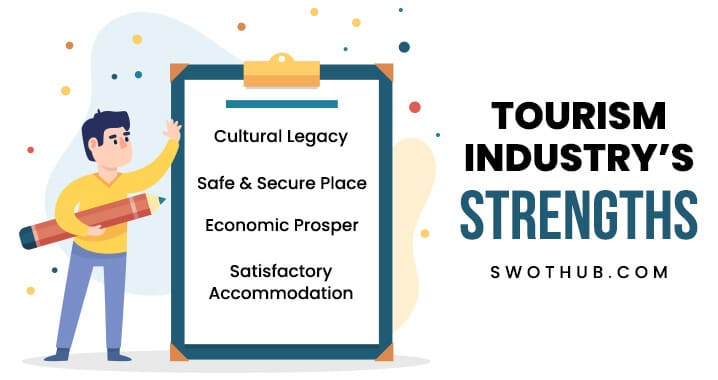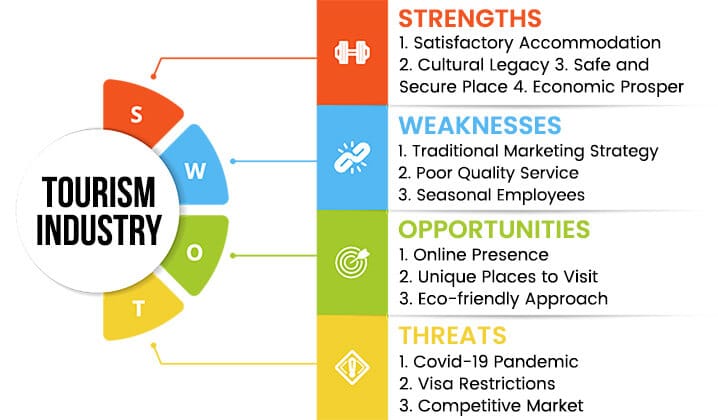Since the pandemic, the tourism industry has been gaining popularity, and more travelers want to see the world again. A Tourism Industry SWOT Analysis is essential to see how lucrative this industry has become. Any industry that directly supplies goods or services to enhance business, enjoyment, or leisure activities away from home is included in the tourism sector. Tourism’s significance stems from the multiple benefits and advantages to every host country.
The Travel & Tourism market report, according to statista.com, comprises all travel deals bought via online travel agencies, a provider’s website, at a travel agency, or by phone has a global revenue of $297 billion in 2020 and is predicted to rise to $950 billion by 2026. A SWOT analysis of tourism will help to break down the travel and tourism industry.
Table of Contents
Tourism Industry SWOT Analysis Competitors
Some of the largest competitors in the tourism sector are the hotel and lodging sectors, airlines, travel agencies, cruise lines, and tour operators. These rivals’ strengths may include their well-known brand name and extensive experience in the industry. A weakness could be a severe lack of creative marketing or customer service. Emerging markets, technological developments, and collaborations could all present opportunities. Threats might be brought on by evolving consumer demands, fresh technologies, or heightened competition. These areas should be considered when reviewing the tourism industry SWOT analysis.
Tourism Industry SWOT Analysis
SWOT analysis is a method for assessing the system’s strengths, weaknesses, opportunities, and threats. This approach maximizes the strengths and possibilities while minimizing the drawbacks and risks to identify the best tourist tactics.
This Tourism Industry SWOT Analysis can achieve long-term development and success in attracting tourists, particularly worldwide. The typical SWOT analysis is insufficient in tourism and tourist research and studies. Tourism should be examined and handled as a system, without a systematic approach, all system components would be overlooked. Let us take a look at tourism’s strengths and weaknesses and how the travel industry can improve and celebrate!
Strengths of the Tourism Industry in SWOT Analysis

Strengths of the tourism industry SWOT analysis are necessary for the industry. It is impossible to meet business objectives unless one understands one’s capabilities. This strength analysis will assist you in identifying areas where you outperform your competition to improve your decision-making strategy. A SWOT analysis in tourism will help understand these strengths.
Cultural Legacy: Cultural legacy fosters respect in one’s history. It encourages peace and understanding in international tourism by appreciating and understanding different cultures. For many tourists, cultural heritage and historical sites are the primary interest. Students of archaeology and history are also vital demographics for such establishments.
Safe and Secure Place: Group activities and the presence of many people in various locations around a country provide a sense of safety and security. The secure atmosphere offers a solid foundation for every tourist location to attract more visitors. It’s because people don’t want to endanger their lives by visiting a volatile nation.
Economic Prosper: The tourism industry increases the economy’s revenue, produces thousands of employment, builds a country’s infrastructure, and creates a sense of cultural interaction between visitors and natives. The travel business is highly significant to a country’s GDP and economy.
For example, the United States travel and tourist industry contributed the most to the GDP of any country in the world, with a total contribution of 1.1 trillion US dollars in 2020.
Satisfactory Accommodation: People are also drawn to various motels and accommodations for multiple categories. Many prosperous tourist destinations have restaurant and hotel chains. They provide tourists and visitors with an excellent location to stay. As a result, it produces additional job possibilities for citizens and raises revenue for the local government.
Weaknesses of Tourism Industry in SWOT Analysis

Industry stakeholders can address the weaknesses identified in the tourism industry SWOT analysis. Some flaws can prohibit you from completing your purpose and goals; therefore, it’s well worth it if you can solve them.
Traditional Marketing Strategy: The majority of businesses in the tourist sector apply traditional marketing tactics. They are effective but have a limited reach, such as billboards, television commercials, newspaper ads, magazines, and referrals. These will not help in attracting an international audience. Only a few employ sponsored posts on various social media networks to target their specialized niche.
Poor Quality Service: When many people visit a particular location during the season, the service quality declines. We frequently hear clients complain about their unpleasant experiences with various travel agents. However, some well-known hotels, restaurants, and local travel businesses give excellent service in other places.
Seasonal Employees: Businesses in the hotel sector do not recruit personnel on a long-term basis. They give their poor staff wages and do not invest in training programs. In this industry, employee satisfaction is relatively not so good. An inconsistency in the staff also lowers the level of customer satisfaction.
Tourism Industry SWOT Analysis Opportunities

Recognizing the opportunities from the tourism industry SWOT analysis would help you act on and leverage, which may boost the success of your own company or endeavor or better understand the conditions other firms are experiencing. A tourism opportunity analysis could help understand what positive outcomes could arise if the opportunities are pursued.
Online Presence: Potential clients will be more likely to trust you if you have a solid online presence and a well-designed website. A captivating and well-marketed website will assist tour operators in deciding whether or not to do business with your organization. Social media marketing is the most effective way to identify and promote their target audience.
Unique Places to Visit: Attractions are a significant part of tourism since they attract visitors. The attractions are the locations, people, activities, and things that serve as the objects of tourists’ attention and draw them to a place. Suppose you can raise funds, work on the property, and develop a suitable location. In that case, you will attract a large number of tourists.
Eco-friendly Approach: Ecotourism refers to a manner of vacationing that adheres to environmental, social, and economic sustainability—a dedication to having a common cultural and ecological effect. If you build an eco-friendly location, you will attract environmentally-conscious visitors.
Tourism Industry SWOT Analysis Threats

Unexpected threats can have disastrous consequences for any organization, which is why they must be considered in the tourism industry SWOT analysis. If you can forecast them, you can minimize their influence or avoid them altogether.
The COVID-19 Pandemic: The tourism sector has suffered dramatically due to the lockdown and closure of enterprises caused by the covid-19 outbreak. The restriction of hotels and restaurants as a result of the nationwide lockdown and the prohibition on air travel cost the business billions of dollars. Consequently, many individuals lost their employment, and many small firms went bankrupt.
Visa Restrictions: Visa restrictions are a crucial obstacle to the tourist business. It is pretty tough to obtain a tourist visa for several nations. Many potential clients cannot enter specific countries due to the government’s harsh immigration and visa regulations. As a result, local companies do not receive enough visitors to meet sales targets.
Competitive Market: Tourism has developed as one of the world’s largest, fastest expanding, and most competitive sectors in the 20th century. Many small enterprises have entered the fray, offering low-quality services at exorbitant costs. Customers are also dissatisfied as a result of this.
Tourism Industry SWOT Analysis Overview Template

Conclusion and Recommendations for Tourism Industry SWOT Analysis
Here are a few suggestions for the future development of the tourism industry:
- Digital technology is a topic that you should consider. After the COVID-19 situation, as more employees choose remote and telecommuting, technology will increase long-term tourism.
- It will help if you focus on rebuilding the tourism sector and delivering gratifying experiences for visitors, which will be accomplished through discovering options for mass tourism.
- Increasing the supply of clean water and sanitation facilities and promoting good hygiene like hand washing would also help you provide safe tourism. We should encourage internet service providers to increase internet connections in tourist areas.
FAQs for the Tourism Industry
How profitable is the tourism industry?
The tourism industry generates immense revenue globally, contributing over $9 trillion to the global economy in recent years, and it continues to grow as people seek travel experiences.
How much money does the US make on tourism?
In the US, tourism is a substantial economic driver, contributing around $1.6 trillion annually to the economy, supporting jobs and various sectors across the nation.
What are 5 examples of the tourism industry?
Travel agencies, hotels, restaurants, airlines, cruises, theme parks, landmarks, festivals, and conferences are examples of the tourism sector. These parts shape tourism’s dynamic terrain.
Following an in-depth review of the Tourism Industry SWOT Analysis, we determined that the industry is really expanding rapidly. However, the tourism sector is a thriving enterprise, with visa limits, government rules, and other tangible and significant risks.
Moreover, the COVID-19 outbreak has shut down it all and created an unsettled atmosphere. But that’s not the end; people in this industry should work together to overcome this disaster.





